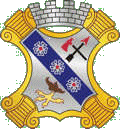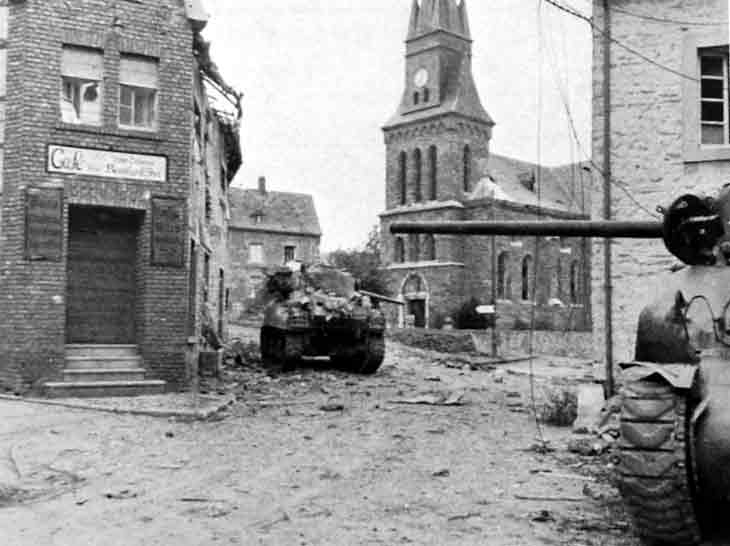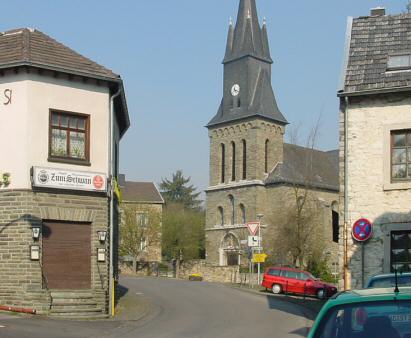(4TH INFANTRY DIVISION) IN THE HURTGEN FOREST,
GERMANY, 16-22 NOVEMBER 1944
(RHINELAND CAMPAIGN)
By Lieutenant Colonel James W. Haley

THE BATTALION SITUATION
On 13 November the 2nd Battalion was still in its initial assembly area east of Zweifall. For the past several days the foremost question in the mind of every man in the battalion had been as to when and where the coming attack would be made. And now on 13 November the answer to this question was forthcoming. Late in the afternoon the Battalion Commander, Lieutenant Colonel Langdon A. Jackson, was called to the Regimental Command Post to receive the attack order. 22
The order called for the regiment to attack in a column of battalions in the order of 2nd Battalion, 3rd Battalion and 1st Battalion. The zone of attack of the 2nd Battalion was left to the discretion of Commanding Officer, 2nd Battalion, as long as his attack remained within the zone of action of the regiment. This zone of action extended from the road running east from Schevenhütte, inclusive, to a point about 2500 yards to the southeast. (See Map D) The 2nd platoon of Company A, 70th Tank Battalion, was to be attached to the 2nd Battalion, end the 2nd Platoon of Company A, 4th Engineer Battalion, was to support the attack. The attack was to begin on the first suitable day for air operations and not later than 16 November. 23
At 0900 on 14 November, the Battalion Commander of the 2nd Battalion, together with his Executive Officer, S-3 and Company Commanders, departed for the Command Post of the 2nd Battalion, 47th Infantry, which was holding the line in the regimental zone of action. From this point the party was to proceed on a reconnaissance of the future zone of action of the Battalion after obtaining all available information from the 2nd Battalion, 47th Infantry. 24

Schevenhütte, a pair of M4A1 (76 mm) Sherman tanks of the 3rd Armored Division
are seen in front of the St. Josef Church (Sept. 1944)
On arriving at the Command Post of the 2nd Battalion, 47th Infantry, a conference was held with the Battalion Commander and the staff of that unit. It was learned that F and G Companies were holding the sector through which the 2nd Battalion, 8th Infantry, was to attack and that information of the enemy defenses was very limited. The front line positions of 2nd Battalion, 47th Infantry, ran generally northwest to southeast about half way up the east slope of the ravine in which Schevenhütte is located and extended from a point east of Schevenhütte southeast to the rock quarry and thence south across the road. It was learned that the enemy position ran generally about 200 yards back from the top of the hill, that this position included barbed wire entanglements of unknown extent or type and log bunkers, whose exact locations were unknown. No information on mine fields was available except that the road running east from Schevenhütte was mined and blocked. (See Map D) 25

No Shermans standing guard today.
Lieutenant Colonel Jackson, realizing that this information was insufficient, requested of the Commanding Officer, 2nd Battalion, 47th Infantry, that his battalion send out reconnaissance patrols to secure additional information of the enemy position. Lieutenant Colonel Jackson was prohibited from sending out patrols, from his battalion by orders which had been necessitated for security reasons. The risk of having a prisoner from the 4th Infantry Division fall into the hands of the enemy, thereby revealing the coming attack, could not be taken. However, the request could not be complied with by the 2nd Battalion, 47th Infantry, since personnel was not available because of the greatly over-extended front of this unit. 26
The Commanding Officer, 2nd Battalion and his party than proceeded to reconnoiter the front line positions of the 2nd Battalion, 47th Infantry. This reconnaissance was completed by mid-afternoon but the results were disappointing. Observation was very limited because of the thick woods and because of the fact that the commanding ground was in the hands of the enemy. No locations of enemy positions were obtained except for that of a machine gun which fired on the party from Hill 280 on the right flank of the sector. However, the opportunity to study the terrain over which the battalion was to attack proved of great benefit. Especially noted were the two rock quarries located about half way up the slope of the ravine, one in the center of the sector and one on the left flank, and the two trails leading up to them. Both of these quarries were located just within the lines of the 2nd Battalion, 47th Infantry. (See Map D) 27
The Commanding Officer, 2nd Battalion, and his party returned to the Battalion Command Post late on the afternoon of 14 November and began laying plans for the attack. At about 1800, orders ware issued for the movement of the Battalion from its present location to a forward assembly area in the vicinity of the village of Bend. This movement was to begin at 0900 on 15 November. The Command Post of the 2nd Battalion was to be established in Bend and was to displace early on the morning of 15 November. (See Map D) 28
The Battalion closed into the forward assembly area at 1100 on 15 November and the companies began preparations for the coming attack. Weapons and equipment were checked, ammunition was issued and all the other details taken care of. Routes forward to the line of departure were reconnoitered by platoon leaders, and squad leaders were oriented on the terrain and general situation. A location for the Battalion Observation Post was selected on the east slope of the ravine southeast of Schevenhütte. During the day, this observation post was dug in and communication lines were laid. The 81 mm Mortar Platoon selected firing positions just northeast of Bend, dug in the mortars and dumped ammunition on the position. These preparations were well under way when the Battalion Commander issued the order for the attack at 1200 hours at the new Command Post in Bend. (See Map D) 29
The bad weather which had heretofore prevented air operations continued through 15 November. Plans for the vast air attack had been completed several days prior to this time and the Air Forces were waiting for clear skies to launch the attack.
A complete and detailed plan for marking the front lines had been prepared and disseminated. It was hoped that this plan would prevent the bombers from dropping their loads on friendly troops, These thorough preparations all seemed in vain since the weather forecast for 16 November was for continued cloudiness with fog and mist. It was feared that the attack would have to be made without the planned air support. 30

